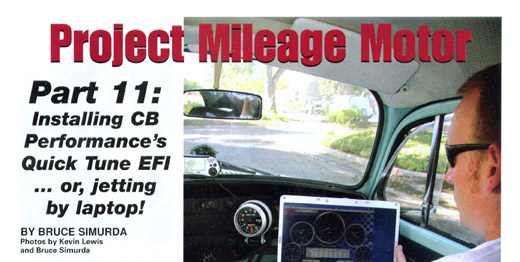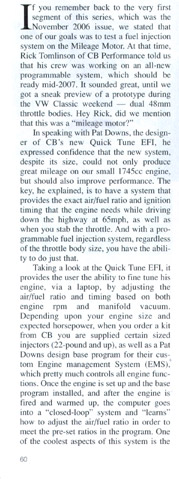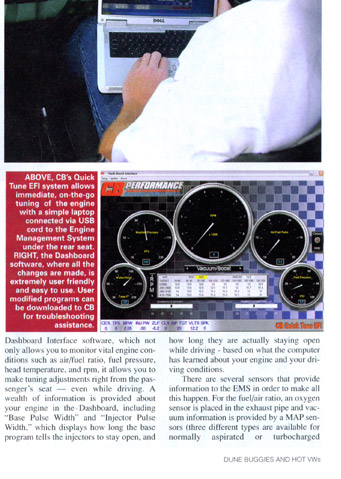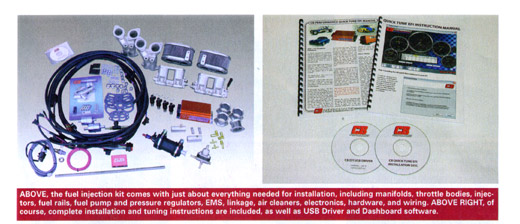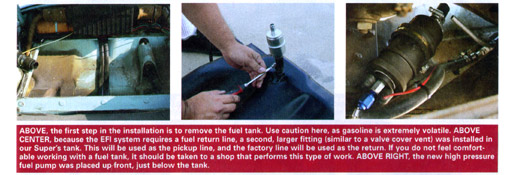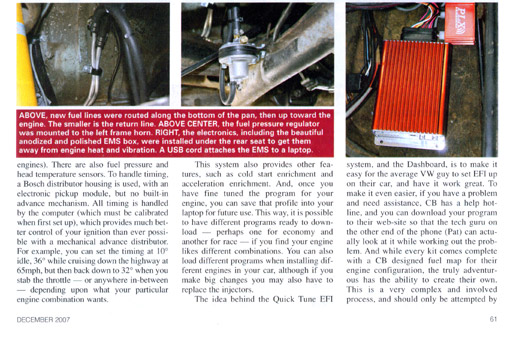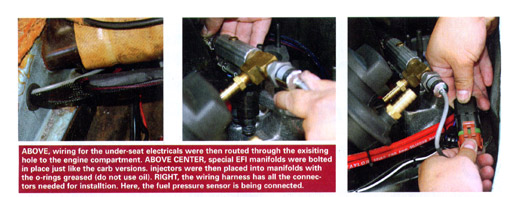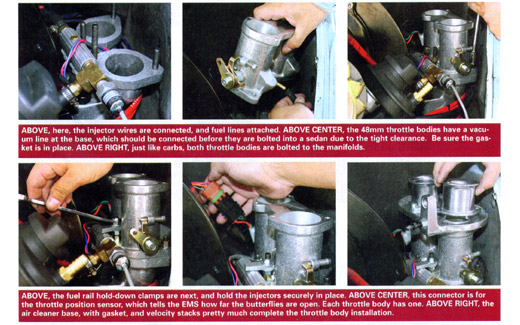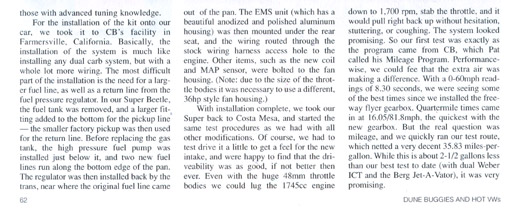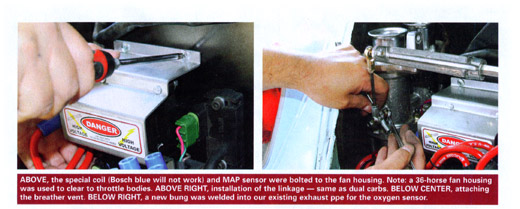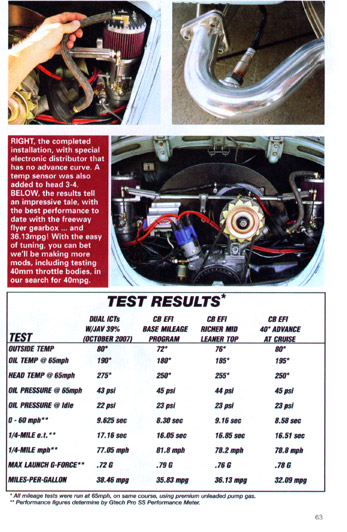|
Hot VWs - December 2007 - Project Mileage Motor - Part 11 Installing CB Performance's Quick Tune EFI... or, jetting by laptop!
Project
Mileage Motor BY BRUCE SIMURDA If you remember back to the very fist segment of this series, which was the November 2006 issue, we stated that one of our goals was to test a fuel injection system on the Mileage Motor. At that time, Rick Tomlinson of CB Performance told us that his crew was working on an all-new programmable system, which should be ready mid-2007. It sounded great, until we got a sneak preview of a prototype during the VW Classic weekend - dual 48mm throttle bodies. Hey Rick, did we mention that this was a "mileage motor?" In speaking with the designer of CB's new Quick Tune EFI, he expressed confidence that the new system, despite its size, could not only produce great mileage on our small 1745cc engine, but should also improve performance. The key, he explained, is to have a system that provides the exact air/fuel ratio and ignition timing that the engine needs while driving down the highway at 65mph, as well as when you stab the throttle. And with a programmable fuel injection system, regardless of the throttle body size, you have the ability to do just that. Taking a look at the Quick Tune EFI, it provides the user the ability to fine tune his engine, via a laptop, by adjusting the air/fuel ratio and timing based on both engine rpm and manifold vacuum. Depending upon your engine size and expected horsepower, when you order a kit from CB you are supplied certain sized injectors (22-pound and up), as well as a base program for their custom Engine management System (EMS),' which pretty much controls all engine functions. Once the engine is set up and the base program installed, and after the engine is fired and warmed up, the computer goes into a "closed-loop" system and "learns" how to adjust the air/fuel ratio in order to meet the pre-set ratios in the program. One of the coolest aspects of this system is the Dashboard Interface software, which not only allows you to monitor vital engine conditions such as air/fuel ratio, fuel pressure, head temperature, and rpm, it allows you to make tuning adjustments right from the passenger's seat - even while driving. A wealth of information is provided about your engine in the Dashboard, including "Base Pulse Width" and "Injector Pulse Width, which displays how long the base program tells the injectors to stay open, and how long they are actually staying open while driving - based on what the computer has learned about your engine and your driving conditions. There are several sensors that provide information to the EMS in order to make all this happen. For the fuel/air ratio, an oxygen sensor is placed in the exhaust pipe and vacuum information is provided by a MAP sensors (three different types are available for normally aspirated or turbocharged engines). There are also fuel pressure and fixed temperature sensors. To handle timing, a Bosch distributor housing is used, with an electronic pickup module, but no built-in advance mechanism. All timing is handled by the computer (which must be calibrated when first set up), which provided much better control of your ignition than ever possible with a mechanical advance distributor. For example, you can set the timing at 10 degrees idle, 36 degrees while cruising down the highway at 65 mph, but then back down to 32 degrees when you stab the throttle - or anywhere in-between - depending upon what your particular engine combination wants. This system also provides other features, such as cold start enrichment and acceleration enrichment. And, once you have fine tuned the program for your engine, you can save that profile into your laptop for future use. This way, it is possible to have different programs ready to download - perhaps one for economy and another for race - if you find your engine likes different combinations. You can also load different programs when installing different engines in your car, although if you make big changes you may also have to replace the injectors. The idea behind the Quick Tune EFI system, and the Dashboard, is to make it easy for the average VW guy to set EFI up on their car, and have it work great. To make it even easier, if you have a problem and need assistance, CB has a help hotline, and you can download your program to their web-site so that the tech guru on the other end of the phone (Pat) can actually look at it while working out the problem. And while every kit comes complete with a CB designed fuel map for their engine configuration, the truly adventurous has the ability to create their own. This is a very complex and involved process, and should only be attempted by those with advance tuning knowledge. For the installation of the kit onto our car, we took it to CB's facility in Farmersville, California. Basically, the installation of the system is much like installing any dual carb system, but with a whole lot more wiring. The most difficult part of the installation is the need for a larger fuel line, as well as a return line from the fuel pressure regulator. In our Super Beetle, the fuel tank was removed, and a larger fitting added to the bottom for the pickup line - the smaller factory pickup was then used for the return line. Before replacing the gas tank, the high pressure fuel pump was installed just below it, and two new fuel lines run along the bottom edge of the pan. The regulator was then installed back by the trans, near where the original fuel line came out of the pan. The EMS unit (which has a beautiful anodized and polished aluminum housing) was then mounted under the rear seat, and the wiring routed through the stock wiring harness access hole to the engine. Other items, such as the new coil and MAP sensor, were bolted to the fan housing. (Note: due to the size of the throttle bodies it was necessary to use a different, 36hp style fan housing.) With installation complete, we took our Super back to Costa Mesa, and started the same test procedures as we had with all other modifications. Of course, we had to test drive it a little to get a eel for the new intake, and were happy to find that the the driveability was as good, if not better then ever. Even with the huge 48mm throttle bodies we could lug the 1745cc engine down to 1,700 rpm, stab the throttle, and it would pull right back up without hesitation, stuttering, or coughing. The system looked promising. So our first test was exactly as the program came from CB, which Pat called his Mileage Program. Performance-wise, we could feel that the extra air was making a difference. With a 0-60mph reading of 8.30 seconds, we were seeing some of the best times since we installed the freeway flyer gearbox. Quarter mile times came in at 16.05/81.8mph, the quickest with the new gearbox. But the real question was mileage, and we quickly ran our test route, which netted a very decent 35.83 miles-per-gallon. While this is about 2-1/2 gallons less than our best test to date (with dual Weber ICT and the Berg Jet-A-Vator), it was very promising. For our next test we fired up the laptop, opened the Dashboard, and richened the fuel/air mixture in the areas on our cruising speed (2,801 - 3,800 rpm and -14 to -8 inches of vacuum) from 15:1 fuel air ratio to 14, and leaned the top end richness slightly. Unfortunately, in the 1/4-mile the results were not what we wanted (16.85/78.2mph), but on our mileage cruise we jumped slightly to 36.13 mpg. We were headed in the right direction, at least mileage-wise. Before doing anything else, we saved that program, so we could always go back to it at a later date to see exactly what modifications we made. Then, for our last test this month, we bumped the timing in the cruising speed range from 36 to a full 40 degrees BTDC, and decided to add a little more advance at the top end as well, increasing full throttle advance from 32" to 36" (above 2,001rpm). Although we did puck up a little on performance (16.51/78.8mph), it did not match our very first test, and mileage shot straight down to 32.09mpg. Good thing we saved the earlier programs! At this point we're very impressed with the new CB Quick Tune EFI system. No, it didn't provide the best miles-per-gallon to date, but at 36.13mpg, it's very impressive. And perhaps the best part is, we are not sacrificing performance in order to get that mileage, as was the case with the Jet-A-Vator under Weber ICT carbs - there is tons of top-end with this setup. Of course, at $2,200 (complete kit), a fuel injection system like this is not for everyone, and it depends upon what your gorals are, and what your budget is. But if you want maximum performance with infinite adjustability (we'll be trying new things for months!), and the ability to easily swap the system between engines, then it definitely may be worth looking into. |
|||||||||||||
